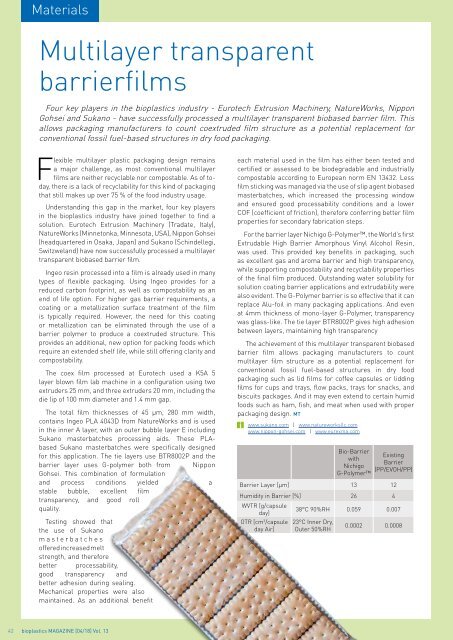Issue 04/2018
bioplasticsMAGAZINE_1804
bioplasticsMAGAZINE_1804
You also want an ePaper? Increase the reach of your titles
YUMPU automatically turns print PDFs into web optimized ePapers that Google loves.
Materials<br />
Multilayer transparent<br />
barrierfilms<br />
Four key players in the bioplastics industry - Eurotech Extrusion Machinery, NatureWorks, Nippon<br />
Gohsei and Sukano - have successfully processed a multilayer transparent biobased barrier film. This<br />
allows packaging manufacturers to count coextruded film structure as a potential replacement for<br />
conventional fossil fuel-based structures in dry food packaging.<br />
Flexible multilayer plastic packaging design remains<br />
a major challenge, as most conventional multilayer<br />
films are neither recyclable nor compostable. As of today,<br />
there is a lack of recyclability for this kind of packaging<br />
that still makes up over 75 % of the food industry usage.<br />
Understanding this gap in the market, four key players<br />
in the bioplastics industry have joined together to find a<br />
solution. Eurotech Extrusion Machinery (Tradate, Italy),<br />
NatureWorks (Minnetonka, Minnesota, USA), Nippon Gohsei<br />
(headquartered in Osaka, Japan) and Sukano (Schindellegi,<br />
Switzweland) have now successfully processed a multilayer<br />
transparent biobased barrier film.<br />
Ingeo resin processed into a film is already used in many<br />
types of flexible packaging. Using Ingeo provides for a<br />
reduced carbon footprint, as well as compostability as an<br />
end of life option. For higher gas barrier requirements, a<br />
coating or a metallization surface treatment of the film<br />
is typically required. However, the need for this coating<br />
or metallization can be eliminated through the use of a<br />
barrier polymer to produce a coextruded structure. This<br />
provides an additional, new option for packing foods which<br />
require an extended shelf life, while still offering clarity and<br />
compostability.<br />
The coex film processed at Eurotech used a K5A 5<br />
layer blown film lab machine in a configuration using two<br />
extruders 25 mm, and three extruders 20 mm, including the<br />
die lip of 100 mm diameter and 1.4 mm gap.<br />
The total film thicknesses of 45 µm, 280 mm width,<br />
contains Ingeo PLA 4<strong>04</strong>3D from NatureWorks and is used<br />
in the inner A layer, with an outer bubble layer E including<br />
Sukano masterbatches processing aids. These PLAbased<br />
Sukano masterbatches were specifically designed<br />
for this application. The tie layers use BTR8002P and the<br />
barrier layer uses G-polymer both from Nippon<br />
Gohsei. This combination of formulation<br />
and process conditions yielded a<br />
stable bubble, excellent film<br />
transparency, and good roll<br />
quality.<br />
Testing showed that<br />
the use of Sukano<br />
masterbatches<br />
offered increased melt<br />
strength, and therefore<br />
better processability,<br />
good transparency and<br />
better adhesion during sealing.<br />
Mechanical properties were also<br />
maintained. As an additional benefit<br />
each material used in the film has either been tested and<br />
certified or assessed to be biodegradable and industrially<br />
compostable according to European norm EN 13432. Less<br />
film sticking was managed via the use of slip agent biobased<br />
masterbatches, which increased the processing window<br />
and ensured good processability conditions and a lower<br />
COF (coefficient of friction), therefore conferring better film<br />
properties for secondary fabrication steps.<br />
For the barrier layer Nichigo G-Polymer, the World’s first<br />
Extrudable High Barrier Amorphous Vinyl Alcohol Resin,<br />
was used. This provided key benefits in packaging, such<br />
as excellent gas and aroma barrier and high transparency,<br />
while supporting compostability and recyclability properties<br />
of the final film produced. Outstanding water solubility for<br />
solution coating barrier applications and extrudability were<br />
also evident. The G-Polymer barrier is so effective that it can<br />
replace Alu-foil in many packaging applications. And even<br />
at 4mm thickness of mono-layer G-Polymer, transparency<br />
was glass-like. The tie layer BTR8002P gives high adhesion<br />
between layers, maintaining high transparency<br />
The achievement of this multilayer transparent biobased<br />
barrier film allows packaging manufacturers to count<br />
multilayer film structure as a potential replacement for<br />
conventional fossil fuel-based structures in dry food<br />
packaging such as lid films for coffee capsules or lidding<br />
films for cups and trays, flow packs, trays for snacks, and<br />
biscuits packages. And it may even extend to certain humid<br />
foods such as ham, fish, and meat when used with proper<br />
packaging design. MT<br />
www.sukano.com | www.natureworksllc.com<br />
www.nippon-gohsei.com | www.eurexma.com<br />
Bio-Barrier<br />
with<br />
Nichigo<br />
G-Polymer<br />
Existing<br />
Barrier<br />
(PP/EVOH/PP)<br />
Barrier Layer [µm] 13 12<br />
Humidity in Barrier [%] 26 4<br />
WVTR [g/capsule<br />
day]<br />
OTR [cm 3 /capsule<br />
day Air]<br />
38°C 90%RH 0.059 0.007<br />
23°C Inner Dry,<br />
Outer 50%RH<br />
0.0002 0.0008<br />
42 bioplastics MAGAZINE [<strong>04</strong>/18] Vol. 13


















